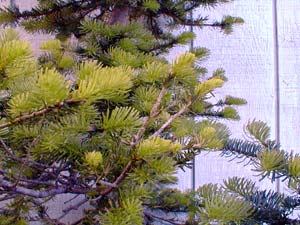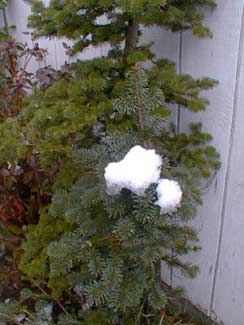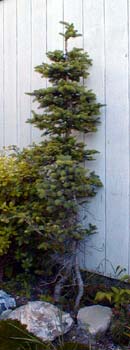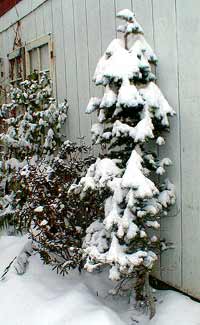
Alpine Fir; or,
Subalpine Fir; aka,
Rocky Mountain Fir
"The trees are awaiting the starlight."
-Chunk Park Lum,
1927
1927
Abies lasiocarpa is native of right here in the Great Northwest, though its full range extends from Arizona to the Yukon throughout the Rocky Mountains, & along coastal mountain ranges from Alaska to Vancouver Island to Washington, & Oregon.
We got a stunted specimen from a local specialist who is lisensed to take plants from the wild. This species grows on mountains from 2,000 feet to a whopping 11,000 feet. "Speedy" growth is only three inches a year, though at its ideal altitude of 5,000 to 8,000 feet, their numbers are abundant & they grow extremely upright like arrows, to a hundred feet of height.
 The nearer to the timberline they grow, the slower their development; many gain only a scant quarter inch in height a year, if that, & at the very highest timberline, they become twisted & prostrate little shrubs.
The nearer to the timberline they grow, the slower their development; many gain only a scant quarter inch in height a year, if that, & at the very highest timberline, they become twisted & prostrate little shrubs.Even those which are not notably stunted, according to one study, it takes them fifteen years to reach eleven inches of seedling height. In shady closed forest conditions, a tree that is a scant six feet tall is apt to be already 30 to 50 years old, & at higher meadow environments above the main forests, a tree at four feet high could already be a century old.
Due in part to the extreme slowness of growth, there are not many trees with which it easily co-habits. In Washington & Oregon it grows successfully alongside Mountain Hemlocks (Tsuga mertensiana). Along the coast of British Columbia to Alaska, it grows amidst Alaska Cedars (Chamaecyparis nootkatensis). In the Rockies it grows with Engelmann Spruce (Picea engelmannii). Throughout its range it shows a preference for cool northern slopes in rainier areas.
Though the Subalpine Fir's range is extensive overall, it is rarely the dominant tree except in a few "climax" tree populations at the higher elevations. Yet it is by no means a fragile tree; it adapts to small difficult areas where no other trees even attempt to establish themselves.
This tree has beautiful grey bark, smooth when the tree is young, but with resin blisters & cracks as it ages. Our stunty dwarf already looks like an old giant with the most amazing cracked bark, yet it is only a columnar seven feet tall, with a secondary trunk about three feet tall.
 When brought down to sea level these remain miniature evergreens, which makes them very popular garden plants. The varied charms of wild stunted specimens are irreproducible by production growing methods, though alpine nurseries do have cultivated forms of merit, including a rounded dwarf called "Green Globe"; a blue-needle form, "Coerulescens"; & a silvered form, "Argentea," developed from the natural corkbark variant A. lasiocarpa var. arizonica which also has a dwarf form, "Arizonica Compacta." To escape the naturally slow growth rate & get these on something of an assembly line, cultivated forms are cloned or grafted onto speedier rootstocks.
When brought down to sea level these remain miniature evergreens, which makes them very popular garden plants. The varied charms of wild stunted specimens are irreproducible by production growing methods, though alpine nurseries do have cultivated forms of merit, including a rounded dwarf called "Green Globe"; a blue-needle form, "Coerulescens"; & a silvered form, "Argentea," developed from the natural corkbark variant A. lasiocarpa var. arizonica which also has a dwarf form, "Arizonica Compacta." To escape the naturally slow growth rate & get these on something of an assembly line, cultivated forms are cloned or grafted onto speedier rootstocks.But because of the reliably dwarfed nature of wild specimens from the higher end of their altitude range; & because of shallow root systems that make them hardy to transplant, Subalpine Firs are all too often stripped from their timberline habitat where they are found as miniature forests dispersed among meadows. They take many decades or even centuries to re-establish their mini-forests, if they ever do. Even giant specimens are harvested willynilly by the lumber industry, destined especially for the manufacture of wooden boxes & crates, doors & frames & planing mill products.
 Thus Subalpine Fir is the first tree to vanish from so-called "managed" lands. In forests that are culled rather than clear-cut & replanted, Subalpine Firs are often the first culls, on the premise that they won't be as good for lumber if harvested later, having a tendency to heart-rot when two centuries old, & having a high blow-down rate because of shallow roots, & never included in the replanting projects because they take way too long to reach a harvestable size.
Thus Subalpine Fir is the first tree to vanish from so-called "managed" lands. In forests that are culled rather than clear-cut & replanted, Subalpine Firs are often the first culls, on the premise that they won't be as good for lumber if harvested later, having a tendency to heart-rot when two centuries old, & having a high blow-down rate because of shallow roots, & never included in the replanting projects because they take way too long to reach a harvestable size.For our own guilt's sake, we prefer to take the local liscensed collector at his word when he assures us that he strives to impact the wild populations minimally, never strips an area, & as much as possible salvages trees from areas of alpine development or from areas already under the lumber industry's destructive control. Little trees have also been "saved" from areas in the Cascades where a deadly pest insect from Europe (Adelges piceae, the Balsam Wooly Adelgid) has been eliminating Subalpine Fir from vast areas of southern Washington & Oregon.
Still, no matter the excuses, we are all of us guilty of negatively impacting the environment whether we make a simple bookshelf out of a length of lumber, or succumb to our lust for an irresistable little tree for a garden.
To do well in sea-level gardens, a Subalpine Fir needs some protection from harsh sunlight, & it would like persistent moisture in well-drained soil, though a rare encounter with drought doesn't generally harm it. In the wild it would experience only cool summers & very cold winters under snowpacks. Still, it is by no means as delicate at sea level as are young Mountain Hemlocks. Though its upward growth is so slow it can hardly be detected, its needle growth is reliable & it thickens & refreshes itself every spring with paler green needles that slowly darken.
Stunted alpine firs don't ordinarily develop the big splendid cones, so we cannot looking forward to those, though it certainly would be nice if it did happen, since the female cones are purplish, the male cones bluish, & both cones appear on the same tree. Occasionally specimens as small as five or six feet tall & twenty to fifty years old do produce cones, but the majority of cones are borne on trees much larger & much older.
Of the four photos on this page, the first & third were snapped in May of 2003. The second picture was snapped in January of 2004 with a bit of snow on one of the branches, & the final picture a week or so later that same January after substantial snowfall.